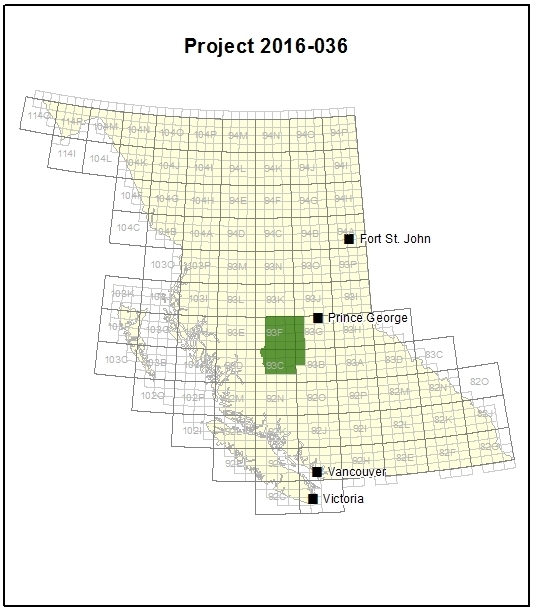The Need
BC’s northern Interior Plateau region is host to several mineral deposits, including the proposed Blackwater gold-silver mine, and has the potential to host many more. The bedrock geology of this underexplored region is largely buried under a blanket of glacial sediments of variable thickness, masking the characteristics of the rocks below. However, certain materials found at the surface can be sampled and analyzed to find trace amounts of the valuable elements, such as gold, copper or molybdenum, below. Sampling these surface materials is easier and less expensive than some other exploration methods, such as drilling, and generates valuable information for explorers focus their search for new mineral resources.
This study extracted and analyzed the clay-sized fraction of over 1,000 samples of till — the mix of gravel, sand and clay left behind after glaciation has affected an area — to produce a more precise, regional-scale data layer for explorers and land managers to use in making decisions about exploration activities and land use in the area. It also evaluated the cost-benefit of the additional cost required to separate the clay-sized fraction for geochemical analysis.
Project Goals
The Clay-Fraction Till Geochemistry project was designed to:
- Analyze the clay-sized fraction of archived till samples from the TREK area;
- Establish whether the extra expense of extracting the clay fraction from tills preceding chemical analysis is justifiable;
- Compare the geochemistry of the two size fractions (<0.002 and <0.063 mm); and
- Correlate the resulting anomalies with known mineral deposits.
Project Benefits
Earth science information gathered from easy-to-access sampling materials helps attract mineral exploration investment to the province, creating jobs and building diverse, sustainable communities. Re-analyzing a portion of previously-collected samples adds value to public geoscience datasets by eliminating the cost of sample collection. Better interpretation of anomalies in existing data increases the likelihood of discovering buried mineralization. In addition to identifying mineral opportunities, the availability of new regional earth science data provides First Nations, regional districts, governments and communities with a better understanding of the resources in their area leading to more informed land-use and resource management decisions.
Survey Area
The TREK project covers a 28,000 km2 area in BC’s Central Interior Plateau from Anahim Lake in the southwest, north and east towards Burns Lake, Vanderhoof and Williams Lake. New Gold’s proposed 8.2 million-ounce Blackwater gold mine is located in the middle of the area, about 160 kilometres southwest of Prince George. See TREK project page for more information.
How was the data collected?
Basal till samples that were collected over the TREK Project area during 2013 and 2014 were archived by the British Columbia Geological Survey (BCGS) in Victoria, BC. The researchers obtained a fraction of 1,222 archived samples and extracted the clay-sized fraction for analysis. The samples were analyzed by aqua-regia digest and ICP-MS (inductively coupled plasma mass spectrometry) finish, following a wet clay-separation process. The geochemical results provided a valuable data layer to be used in conjunction with other regional data, and the results of the analysis were compared with the previously analyzed coarser fraction (less than 0.063 millimeters in size).
What was found?
The study found different mineralogical compositions, and therefore different concentrations of elements, in the clay-sized fraction compared to the coarser fraction. Because of the shape of the clay minerals — tiny, thin plates with a large surface area — and the positively-charged ions within them, metals are preferentially affixed onto the clays. The clays will release these metals during analysis more easily. As a result, trace elements, including copper, are detected more accurately and precisely in the clay fraction.
The researchers concluded that the extra expense of extracting the clay-sized fraction from tills preceding chemical analysis is justifiable given the demonstrated improvement in data quality. They recommend that it be given serious consideration before budget decisions preclude a potential discovery. Any new till sampling program should consider the clay fraction as a preferred medium for greater data precision over conventional size fractions.
 This project analyzed the geochemistry of the clay-size fraction (particle less than 0.002 millimeters in size) of archived till samples from the highly prospective TREK area in central BC, generating a valuable new layer of earth science information and demonstrating the benefits of analyzing the clay-size fraction.
The work relates to the area of Geoscience BC's Targeting Resources for Exploration and Knowledge (TREK) series of projects. View TREK project page.
This project analyzed the geochemistry of the clay-size fraction (particle less than 0.002 millimeters in size) of archived till samples from the highly prospective TREK area in central BC, generating a valuable new layer of earth science information and demonstrating the benefits of analyzing the clay-size fraction.
The work relates to the area of Geoscience BC's Targeting Resources for Exploration and Knowledge (TREK) series of projects. View TREK project page.